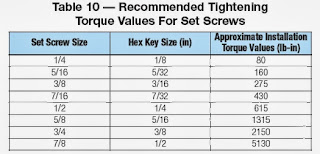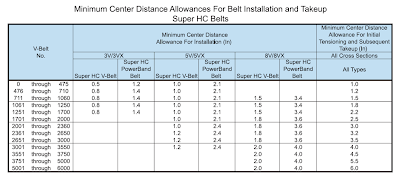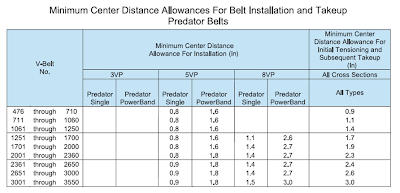Wednesday, October 30, 2013
Got Questions? Gates Experts Are Ready to Help
The complex demands of today’s operations present significant challenges. Preventing downtime, ensuring performance, and controlling costs often require deep expertise in highly technical areas.
You can rely on Gates engineers to help you deal with these issues. Thorough training combined with ongoing, real-world experience gives them a unique ability to analyze your situation and offer solutions that meet your needs. They know the technology inside out. They understand the requirements of your enterprise. And each one is completely invested in your success.
To connect with a Gates engineer, please leave a comment. We’ll be glad to reach out to you.
Tuesday, October 29, 2013
Belt Working Tension Ratings
For long length or linear applications the maximum dynamic drive tension should be compared to the belt’s allowable working tensions for proper belt width selection, rather than the ultimate tensile, or breaking, strength. Working tension ratings are based on the HP ratings for our belts. We simply convert the HP rating to a torque rating at a given speed, and then divide by the sprocket’s radius. It is much better to base drive designs on the prime mover output ratings instead, as this better represents the amount of energy that can potentially be applied to the system. We recommend basing your design on our published HP rating tables or design software, and using an appropriate service factor.
Each driven and driver sprocket should have 60 degrees of wrap and 6 teeth in mesh. 20% of the HP rating will be lost for each tooth less than six not in full contact. For example, if only 5 teeth are in mesh around a driver or driven sprocket the HP rating will be 80% of what’s shown in the attached tables.
Monday, October 28, 2013
John Force Wins 2013 NHRA Funny Car Championship with Gates as Sponsor
John Force won his fourth race of the 2013 season and his record 16th World Championship on October 27 at the NHRA Toyota Nationals at The Strip at Las Vegas Motor Speedway.
John Force faced his daughter Courtney in the final round, with a winning 4.062 second ET at 310.63 MPH run to defeat Courtney's 4.085 second ET at 319.22 MPH.
On his way to the race win and points championship, Force had a wild semi final run, needing repeated "pedaling" to attempt to hook the car up and stop the tires from breaking loose. Pedalling is very harsh on the blower belt drives, with repeated tension reversals and shock loads, but the Gates Poly Chain belt held on to get Force down the track to win the semi final run and set him up for his historic 16th Funny Car championship. Just one more testimonial of the toughest, baddest belt on the planet - Poly Chain GT Carbon.
Tuesday, October 22, 2013
Set Screw Torque Values
Working on my vehicle the other night, I broke a tool from applying too much torque. I should have been using my torque wrench - I know this. Torque values are important. Using the correct torque values when installing set screws does two things: first, it guarentees that you have applied enough torque to keep the set screw from slipping, which could be a safety issue, and second, it keeps damage from occuring to the set screw, the sprocket, and the shaft. Refer to the chart below to find the correct set screw torque for your application.
Tuesday, October 15, 2013
Wind-Milling and Gates Draftguard
 Large air moving fans used in air cooled heat exchangers or
cooling towers sometimes “wind-mill” while powered off. Wind-milling occurs when back drafts cause
fans to rotate backwards when out of service.
This can present safety concerns to personnel working in the proximity
of the fans. It can also damage fan
structures and belt drive systems when the units are powered on and the
counter-rotating fan inertia energy is quickly dissipated and absorbed by the structure
and power transmission system.
Large air moving fans used in air cooled heat exchangers or
cooling towers sometimes “wind-mill” while powered off. Wind-milling occurs when back drafts cause
fans to rotate backwards when out of service.
This can present safety concerns to personnel working in the proximity
of the fans. It can also damage fan
structures and belt drive systems when the units are powered on and the
counter-rotating fan inertia energy is quickly dissipated and absorbed by the structure
and power transmission system.
The Gates Draftguard product eliminates these issues. It consists of a strong one-way clutch that
mounts directly to QD bushing sizes E, F and J and TaperLock bushing sizes
3020, 3525, 3535 and 4030 or directly to fan shafts. With Draftguard mounted and the torque arm
secured, fans can no longer counter-rotate, but are free to rotate normally
when powered on. This eliminates system start-up
shock loads and enables technicians to perform maintenance operations on belt
drive systems without concern of unexpected backwards movement.
Draftguard is a great product to consider when drive shaft
counter-rotation causes safety concerns.
Draftguard also reduces the chance of structural damage and synchronous
belt tooth jumping when high inertia and counter-rotating fans are started.
For more information, contact Gates Product Application Engineering at 303-744-4947 or ptpasupport@gates.com.
Monday, October 7, 2013
How Much Center Distance Adjustment Do YOU Need For Your V-Belt Drive?
When designing a new belt drive system it is important to
ensure that adequate installation and take-up adjustment is provided to allow
the belt(s) to be both properly installed and tensioned throughout the life of
the drive. This is a commonly overlooked
consideration due largely to poor installation and maintenance practices. These practices include rolling belts on when
there is insufficient installation adjustment or lack of a preventative
maintenance schedule to ensure proper tension is maintained. Properly installing and maintaining the drive
will not only result in increased belt life and performance, but will also
increase the overall efficiency of the drive when properly tensioned. A quick reference to the charts
below will help to ensure that the minimum center distance allowances for belt
installation and take-up are achieved.
For any additional questions feel free to contact us at ptpasupport@gates.com or 303-744-5800.
Subscribe to:
Posts (Atom)






